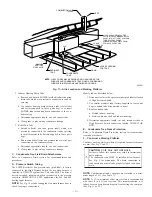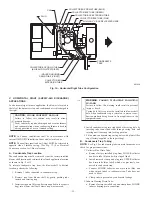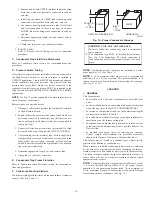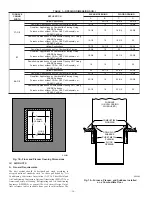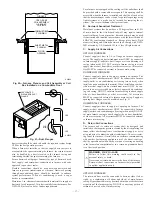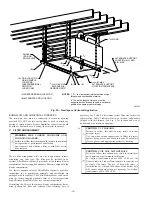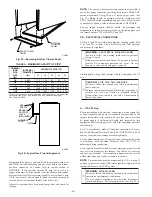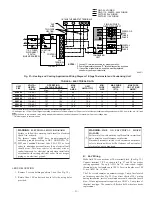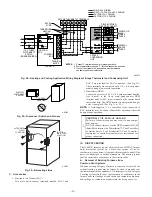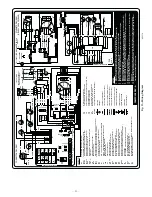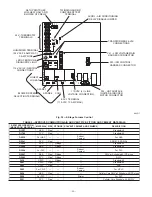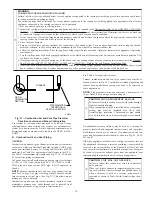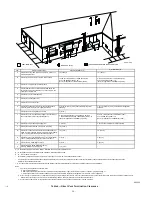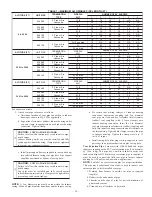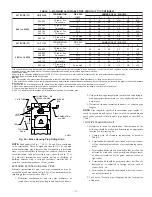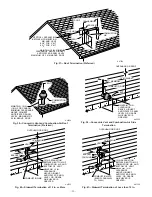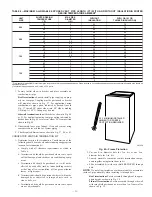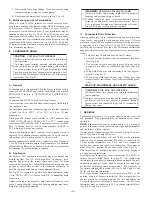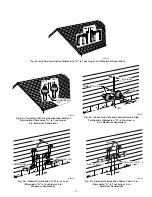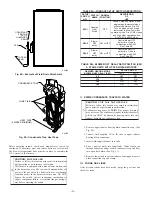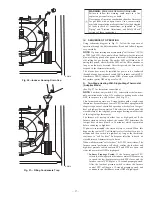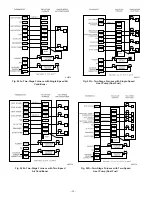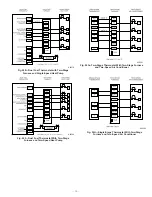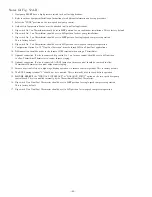
WARNING:
CARBON MONOXIDE POISONING HAZARD
Failure to follow the steps outlined below for each appliance connected to the venting system being placed into operation could result
in carbon monoxide poisoning or death.
The following steps shall be followed for each appliance connected to the venting system being placed into operation, while all other
appliances connected to the venting system are not in operation:
1. Seal any unused openings in venting system.
2. Inspect the venting system for proper size and horizontal pitch, as required in the National Fuel Gas Code, ANSI Z223.1-220/NFPA
54-2002 or the CSA B149.1, Natural Gas and Propane Installation Code and these instructions. Determine that there is no blockage
or restriction, leakage, corrosion and other deficiencies, which could cause an unsafe condition.
3. As far as practical, close all building doors and windows and all doors between the space in which the appliance(s) connected to the
venting system are located and other spaces of the building.
4. Close fireplace dampers.
5. Turn on clothes dryers and any appliance not connected to the venting system. Turn on any exhaust fans, such as range hoods and
bathroom exhausts, so they are operating at maximum speed. Do not operate a summer exhaust fan.
6. Follow the lighting instructions. Place the appliance being inspected into operation. Adjust the thermostat so appliance is operating
continuously.
7. Test for spillage from draft hood equipped appliances at the draft hood relief opening after 5 minutes of main burner operation. Use
the flame of a match or candle.
8. If improper venting is observed during any of the above tests, the venting system must be corrected in accordance with the National
Fuel Gas Code, ANSI Z223.1-2002/NFPA 54-2002 and/or CSA B149.1, Natural Gas and Propane Installation Code.
9. After it has been determined that each appliance connected to the venting system properly vents when tested as outlined above, return
doors, windows, exhaust fans, fireplace dampers and any other gas-fired appliance to their previous conditions of use.
Vent system or vent connectors may need to be resized. For any
other appliances when resizing vent systems or vent connectors,
system or connector must be sized to approach minimum size as
determined using appropriate table found in the NFGC or NSC-
NGPIC.
B.
Combustion-Air and Vent Piping
GENERAL
Combustion-air and vent pipe, fittings, primers, and solvents must
conform to American National Standards Institute (ANSI) stan-
dards and American Society for Testing and Materials (ASTM)
standards. See Table 5 for approved materials for use in the U.S.A.
See Table 7 for maximum pipe lengths and Fig. 37, 38, 39, 40, and
41 for exterior piping arrangements.
In Canada, construct all combustion-air and vent pipes for this unit
of CSA or ULC listed schedule-40 PVC, PVC-DWV or ABS-
DWV pipe and pipe cement. SDR pipe is NOT approved in
Canada.
NOTE:
Furnace combustion-air and vent pipe connections are
sized for 2-in. pipe. Any pipe size change should be made outside
furnace casing in vertical pipe. (See Fig. 33.) This allows proper
drainage of vent condensate.
Combustion-air and vent pipes must terminate together in same
atmospheric pressure zone, either through roof or sidewall (roof
termination preferred), using accessory termination kit.
See Table 6 for required clearances.
Furnace combustion-air and vent pipe connections must be at-
tached as shown in Fig. 34. Combustion-air intake plug fitting and
inducer housing alternate vent cap may need to be relocated in
some applications.
NOTE:
Slope combustion-air and vent pipes a minimum of 1/4
in. per linear ft with no sags between hangers.
CAUTION:
MINOR PROPERTRY DAMAGE
Failure to follow this caution may result in water damage
from condensate dripping.
When combustion-air pipe is installed above a suspended
ceiling, pipe must be insulated with 3/8-in. thick
Armaflex-type insulation. Combustion-air pipe should
also be insulated when it passes through warm, humid
space.
An abandoned masonry chimney may be used as a raceway for
properly insulated and supported combustion-air and vent pipes.
Each furnace must have its own set of combustion-air and vent
pipes and be terminated individually, as shown in Fig. 43, 44, 45,
46, and 47.
Other gas appliances with their own venting system may also use
the abandoned chimney as a raceway providing it is permitted by
local code, the current edition of the National Fuel Gas Code and
the vent or liner manufacturer’s installation instructions. Care must
be taken to prevent the exhaust gases from one appliance from
contaminating the combustion air of other gas appliances.
CAUTION:
UNIT MAY NOT OPERATE
Failure to follow this caution may result in intermittent
unit operation.
When vent pipe is exposed to temperatures below freez-
ing, such as when it passes through an unheated space or
when a chimney is used as a raceway, pipe must be
insulated as shown in Table 8 with Armaflex-type insu-
lation.
Fig. 33—Combustion-Air and Vent Pipe Diameter
Transition Location and Elbow Configuration
A93034
FURNACE
PIPE DIAMETER
TRANSITION IN
VERTICAL SECTION
NOT IN
HORIZONTAL
SECTION
—25—
Содержание CONDENSING GAS FURNACE 352MAV
Страница 51: ...51...

